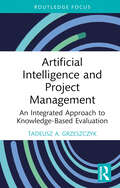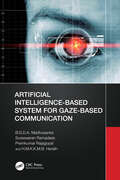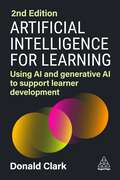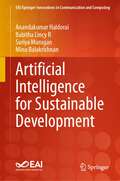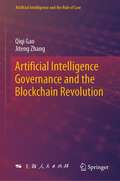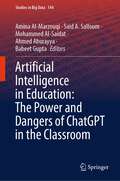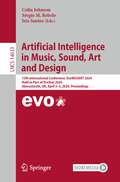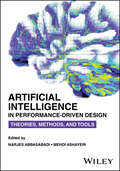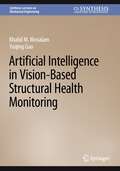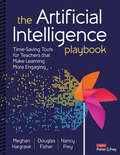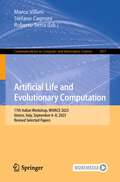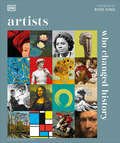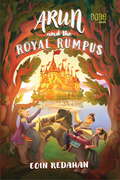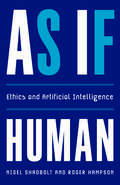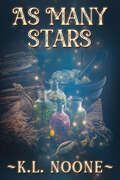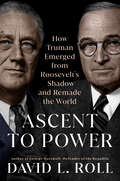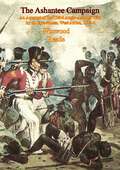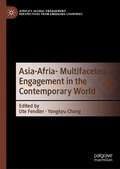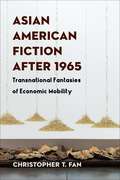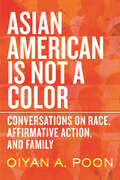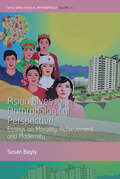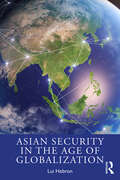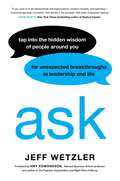- Table View
- List View
Artificial Intelligence and Project Management: An Integrated Approach to Knowledge-Based Evaluation (ISSN)
by Tadeusz A. GrzeszczykAlthough some people had doubts about the usefulness of such solutions in the past, artificial intelligence (AI) plays a growing role in modern business. It can be expected that the interest in it will also lead to an increase in support for the planning, evaluation, and implementation of projects. In particular, the proper functioning of multifaceted evaluation methods has a crucial impact on the appropriate planning and execution of various projects, as well as the effective achievement of the organization’s goals. This book offers a presentation of the complex problems and challenges related to the development of AI in project management, proposes an integrated approach to knowledge-based evaluation, and indicates the possibilities of improving professional practical knowledge in this field.The unique contribution of this book is to draw attention to the possibilities resulting from conducting transdisciplinary research and drawing on the rich achievements in the field of research development on knowledge-based systems that can be used to holistically support the processes of planning, evaluation, and project management. The concept of the integrated approach to knowledge-based evaluation is presented and developed as a result of drawing inspiration mainly from the systems approach, generative AI, and selected mathematical models.Presented in a highly accessible manner, the book discusses mathematical tools in a simple way, which enables understanding of the content by readers across broad subject areas who may be not only participants in specialist training and university students but also practitioners, consultants, or evaluators. This book will be a valuable resource for academics and upper-level students, in particular, across project management-related fields, and of great interest to all those looking to understand the challenges and effectiveness of AI in business.
Artificial Intelligence-Based System for Gaze-Based Communication
by B.G.D.A. Madhusanka Sureswaran Ramadass Premkumar Rajagopal H.M.K.K.M.B. HerathThis book focuses on the artificial neural network-based system for gaze-based communication. It covers the feasible and practical collaboration of human–computer interaction (HCI) in which a user can intuitively express tasks using gaze-based communication. It will target the vast applications of gaze-based communication using computer vision, image processing, and artificial intelligence.Artificial Intelligence-Based System for Gaze-Based Communication introduces a novel method to recognize the implicit intention of users by using nonverbal communication in combination with computer vision technologies. A novel HCI framework is developed to enable implicit and intuitive gaze-based intention communications. This framework allows the users to intuitively express their intention using natural gaze cues. The book also focuses on robot caregiving technology, which can understand the user’s intentions using minimal interactions with the user. The authors examine gaze-based tracking applications for the assisted living of elderly people. The book examines detailed applications of eye-gaze communication for real-life problems. It also examines the advantages that most people can handle gaze-based communications because it requires very little effort, and most of the elderly and impaired can retain visual capability.This book is ideally designed for students, researchers, academicians, and professionals interested in exploring and implementing gaze-based communication strategies and those working in the field of computer vision and image processing.
Artificial Intelligence for Learning: Using AI and Generative AI to Support Learner Development
by Donald ClarkWith Artificial Intelligence (AI) creating huge opportunities for learning and employee development, how can learning professionals best implement the use of AI into their environment?Artificial Intelligence for Learning is the essential guide for learning professionals who want to understand how to use AI to improve all aspects of learning in organizations. This new edition debunks the myths and misconceptions around AI, discusses the learning theory behind generative AI and gives strategic and practical advice on how AI can be used.This book also includes specific guidance on how AI can provide learning support, chatbot functionality and content, as well as ideas on ethics and personalization. This book is necessary reading for all learning practitioners needing to understand AI and what it means in practice.
Artificial Intelligence for Sustainable Development (EAI/Springer Innovations in Communication and Computing)
by Anandakumar Haldorai Babitha Lincy R Suriya Murugan Minu BalakrishnanThis book delves into the synergy between AI and sustainability. This comprehensive guide illuminates the latest trends and cutting-edge techniques, offering invaluable insights for researchers, practitioners, and policymakers interested in the cross-section of AI and sustainability. The authors illustrate how AI-driven innovations are revolutionizing environmental conservation, urban planning, healthcare, and more. The book also considers the ethical considerations and governance frameworks crucial to harnessing AI's potential for global benefit. Whether a seasoned expert or a curious newcomer, this book empowers readers to navigate the dynamic landscape of AI and sustainability, paving the way for a more eco-conscious and equitable world.
Artificial Intelligence Governance and the Blockchain Revolution (Artificial Intelligence and the Rule of Law)
by Qiqi Gao Jiteng ZhangThis is the first professional academic work in China to discuss artificial intelligence and blockchain together. Artificial intelligence is a productivity revolution, and its development has a significant and profound impact on global changes. However, at the same time, its development also brings a series of challenges to human society, such as privacy, security, and fairness issues. Therefore, the significance of blockchain is even more prominent. Blockchain is a revolution in production relations, which will propose important solutions to the challenges of privacy, security, and fairness that arise after the development of artificial intelligence. The book not only discusses the problems currently faced by the development of artificial intelligence, as well as the new opportunities and challenges that artificial intelligence brings to future global governance, but also explains the further development direction of the intelligent revolution from the perspective of blockchain.
Artificial Intelligence in Education: The Power and Dangers of ChatGPT in the Classroom (Studies in Big Data #144)
by Amina Al-Marzouqi Said A. Salloum Mohammed Al-Saidat Ahmed Aburayya Babeet GuptaThis book aims to bring together a collection of innovative and cutting-edge research that addresses the various challenges in the application and theoretical aspects of ChatGPT in education. ChatGPT is a large language model developed by OpenAI that has the ability to generate human-like text based on a prompt. This has significant potential for use in the field of education, as it allows for the creation of personalized, interactive learning experiences, automating assessment and grading, and more. In e-learning, ChatGPT is used to provide instant feedback and support to students, as well as generate interactive conversations in the target language for language learning. It is also integrated with existing learning management systems and educational technology platforms to enhance their capabilities. In research, ChatGPT is used for natural language processing and sentiment analysis to gather insights on student learning experiences and educational outcomes. However, it is important to note that there are also ethical and privacy concerns that come with using language models like ChatGPT in education, such as data protection and the potential for bias. Overall, the use of ChatGPT in education has the potential to revolutionize the way we learn, teach, and access information. The book seeks to publish original manuscripts that cover a broad range of topics, from the development of new chatbot technologies and their integration into the classroom, to the examination of the ethical and pedagogical implications of these systems. By compiling the latest developments in the field and highlighting new areas for exploration, this book provides valuable insights and perspectives for researchers, educators, and practitioners working in the field of ChatGPT and education. The ultimate goal is to advance the understanding of ChatGPT and its role in education and to promote its effective and responsible use in the classroom and beyond.
Artificial Intelligence in Music, Sound, Art and Design: 13th International Conference, EvoMUSART 2024, Held as Part of EvoStar 2024, Aberystwyth, UK, April 3–5, 2024, Proceedings (Lecture Notes in Computer Science #14633)
by Colin Johnson Sérgio M. Rebelo Iria SantosThis book constitutes the refereed proceedings of the 13th International Conference on Artificial Intelligence in Music, Sound, Art and Design, EvoMUSART 2024, held as part of EvoStar 2024, in Aberystwyth, UK, April 3–5, 2024. The 17 full papers and 8 short papers presented in this book were carefully reviewed and selected from 55 submissions. The main purpose of this conference proceedings was to bring together practitioners who are using Artificial Intelligence techniques for artistic tasks, providing the opportunity to promote, present, and discuss ongoing work in the area.
Artificial Intelligence in Performance-Driven Design: Theories, Methods, and Tools
by Narjes Abbasabadi Mehdi AshayeriARTIFICIAL INTELLIGENCE IN PERFORMANCE-DRIVEN DESIGN A definitive, interdisciplinary reference to using artificial intelligence technology and data-driven methodologies for sustainable design Artificial Intelligence in Performance-Driven Design: Theories, Methods, and Tools explores the application of artificial intelligence (AI), specifically machine learning (ML), for performance modeling within the built environment. This work develops the theoretical foundations and methodological frameworks for utilizing AI/ML, with an emphasis on multi-scale modeling encompassing energy flows, environmental quality, and human systems. The book examines relevant practices, case studies, and computational tools that harness AI’s capabilities in modeling frameworks, enhancing the efficiency, accuracy, and integration of physics-based simulation, optimization, and automation processes. Furthermore, it highlights the integration of intelligent systems and digital twins throughout the lifecycle of the built environment, to enhance our understanding and management of these complex environments. This book also: Incorporates emerging technologies into practical ideas to improve performance analysis and sustainable design Presents data-driven methodologies and technologies that integrate into modeling and design platforms Shares valuable insights and tools for developing decarbonization pathways in urban buildings Includes contributions from expert researchers and educators across a range of related fields Artificial Intelligence in Performance-Driven Design is ideal for architects, engineers, planners, and researchers involved in sustainable design and the built environment. It’s also of interest to students of architecture, building science and technology, urban design and planning, environmental engineering, and computer science and engineering.
Artificial Intelligence in Vision-Based Structural Health Monitoring (Synthesis Lectures on Mechanical Engineering)
by Khalid M. Mosalam Yuqing GaoThis book provides a comprehensive coverage of the state-of-the-art artificial intelligence (AI) technologies in vision-based structural health monitoring (SHM). In this data explosion epoch, AI-aided SHM and rapid damage assessment after natural hazards have become of great interest in civil and structural engineering, where using machine and deep learning in vision-based SHM brings new research direction. As researchers begin to apply these concepts to the structural engineering domain, especially in SHM, several critical scientific questions need to be addressed: (1) What can AI solve for the SHM problems? (2) What are the relevant AI technologies? (3) What is the effectiveness of the AI approaches in vision-based SHM? (4) How to improve the adaptability of the AI approaches for practical projects? (5) How to build a resilient AI-aided disaster prevention system making use of the vision-based SHM? This book introduces and implements the state-of-the-art machine learning and deep learning technologies for vision-based SHM applications. Specifically, corresponding to the above-mentioned scientific questions, it consists of: (1) motivation, background & progress of AI-aided vision-based SHM, (2) fundamentals of machine learning & deep learning approaches, (3) basic AI applications in vision-based SHM, (4) advanced topics & approaches, and (5) resilient AI-aided applications. In the introduction, a brief coverage about the development progress of AI technologies in the vision-based area is presented. It gives the readers the motivations and background of the relevant research. In Part I, basic knowledges of machine and deep learning are introduced, which provide the foundation for the readers irrespective of their background. In Part II, to verify the effectiveness of the AI methods, the key procedure of the typical AI-aided SHM applications (classification, localization, and segmentation) is explored, including vision data collection, data pre-processing,transfer learning-based training mechanism, evaluation, and analysis. In Part III, advanced AI topics, e.g., generative adversarial network, semi-supervised learning, and active learning, are discussed. They aim to address several critical issues in practical projects, e.g., the lack of well-labeled data and imbalanced labels, to improve the adaptability of the AI models. In Part IV, the new concept of “resilient AI” is introduced to establish an intelligent disaster prevention system, multi-modality learning, multi-task learning, and interpretable AI technologies. These advances are aimed towards increasing the robustness and explainability of the AI-enabled SHM system, and ultimately leading to improved resiliency.The scope covered in this book is not only beneficial for education purposes but also is essential for modern industrial applications. The target audience is broad and includes students, engineers, and researchers in civil engineering, statistics, and computer science. Unique Book Features:• Provide a comprehensive review of the rapidly expanding field of vision-based structural health monitoring (SHM) using artificial intelligence approaches. • Re-organize fundamental knowledge specific to the machine and deep learning in vision tasks.• Include comprehensive details about the procedure of conducting AI approaches for vision-based SHM along with examples and exercises.• Cover a vast array of special topics and advanced AI-enabled vision-based SHM applications.• List a few potential extensions for inspiring the readers for future investigation.
The Artificial Intelligence Playbook: Time-Saving Tools for Teachers that Make Learning More Engaging
by Meghan Hargrave Douglas Fisher Nancy FreyTime Saving AI Tools that Make Learning More Engaging Busy educators need tools that support their planning and provide them with more time with students. While Artificial Intelligence (AI) has emerged as a promising solution, it can only help if we’re willing to learn how to use it in ways that improve upon what we already do well. The Artificial Intelligence Playbook: Time Saving Tools that Make Learning More Engaging is here to empower teachers to explore AI’s potential and discover practical ways to implement it to enhance their planning and instruction. Two chapters and 6 "Educator Functions" guide teachers step-by-step through how to purposely use AI to: Compose Writing Prompts and Avoid Plagiarism Manage Content Foster Student Engagement Meet Students’ Instructional Needs Assess Student Learning Continue Lifelong Learning Though AI has the potential to reduce workload for educators, it will never replace teachers. Your connection with students is irreplaceable—and greatly impacts their learning. Consider AI a valuable tool that provides you with more time to build and sustain those vital relationships with students and that can assist them in learning at the very same time.
The Artificial Intelligence Playbook: Time-Saving Tools for Teachers that Make Learning More Engaging
by Meghan Hargrave Douglas Fisher Nancy FreyTime Saving AI Tools that Make Learning More Engaging Busy educators need tools that support their planning and provide them with more time with students. While Artificial Intelligence (AI) has emerged as a promising solution, it can only help if we’re willing to learn how to use it in ways that improve upon what we already do well. The Artificial Intelligence Playbook: Time Saving Tools that Make Learning More Engaging is here to empower teachers to explore AI’s potential and discover practical ways to implement it to enhance their planning and instruction. Two chapters and 6 "Educator Functions" guide teachers step-by-step through how to purposely use AI to: Compose Writing Prompts and Avoid Plagiarism Manage Content Foster Student Engagement Meet Students’ Instructional Needs Assess Student Learning Continue Lifelong Learning Though AI has the potential to reduce workload for educators, it will never replace teachers. Your connection with students is irreplaceable—and greatly impacts their learning. Consider AI a valuable tool that provides you with more time to build and sustain those vital relationships with students and that can assist them in learning at the very same time.
Artificial Life and Evolutionary Computation: 17th Italian Workshop, WIVACE 2023, Venice, Italy, September 6–8, 2023, Revised Selected Papers (Communications in Computer and Information Science #1977)
by Marco Villani Stefano Cagnoni Roberto SerraThis book constitutes the refereed post proceedings of the 17th Italian Workshop on Artificial Life and Evolutionary Computation, WIVACE 2023, held in Venice, Italy, during September 6–8, 2023.The 30 full papers included in this book were carefully reviewed and selected from 55 submissions. They were organized in topical sections as follows: Algorithms for complex systems, Biologically inspired models, Complex chemical systems, Adaptation and swarms, Learning, Medicine and Social systems.
Artists Who Changed History (DK History Changers)
by DKThis visual celebration of the world's most celebrated thinkers tells the fascinating stories of their lives and pioneering ideas.Artists Who Changed History places well-known artists in their historical and cultural context, showing you how they came to influence Art as we know it today. This illustrated guide is ideal for those interested in art, sculptures, and the history of art or who would like to broaden their general understanding of art and the lives of artists.Inside this book on artists, you’ll find:-An overview of the lives and works of around 80 of the world's most influential artists - Middle Ages to the present day-Eight pages of brand-new content with 12 new entries, including Judith Leyster and Frank Bowling-Lavishly illustrated portraits of each artist alongside photographs of their homes and studios, original sketches, notebooks, lettersIn this Art guide, each artist is introduced with a realistic portrait and biographical entries that trace the friendships, loves, and rivalries that inspired and influenced them. Entries explore each individual's key ideas and working methods and set their ideas in context, conveying a powerful sense of the place and the period of history in which they lived. Artists Who Changed History provides revealing insights into what drove each individual to develop new ways of understanding the world.
Arun and the Royal Rumpus
by Eoin RedahanWould you rather have the body of a tiger and the head of a boy, or the body of a boy and the head of a tiger?(Arun wants to know)When Arun, a twelve-year-old mischief maker hiding in the mountains, finds out about the plot to capture the crazy King Lalu, he vows to stop the vicious Vin and his thugs - by joining them. Armed only with a pea-shooter, Arun journeys through treacherous terrain, eerie forests, rushing rivers and even the sewers of Asamana with the help of the quick-tempered Krishma and scrappy Sai. Whether it's outsmarting the brutes, stealing a grouchy giant's keys, or trotting down a narrow mountain ledge on a one-eyed pony, Arun is ready to brave it all to save the king. Brimming with humour and adventure, this is not just one boy's gritty tale of friendship, family and mayhem- it's a downright royal rumpus!
As If Human: Ethics and Artificial Intelligence
by Nigel Shadbolt Roger HampsonA new approach to the challenges surrounding artificial intelligence that argues for assessing AI actions as if they came from a human being Intelligent machines present us every day with urgent ethical challenges. Is the facial recognition software used by an agency fair? When algorithms determine questions of justice, finance, health, and defense, are the decisions proportionate, equitable, transparent, and accountable? How do we harness this extraordinary technology to empower rather than oppress? Despite increasingly sophisticated programming, artificial intelligences share none of our essential human characteristics—sentience, physical sensation, emotional responsiveness, versatile general intelligence. However, Nigel Shadbolt and Roger Hampson argue, if we assess AI decisions, products, and calls for action as if they came from a human being, we can avert a disastrous and amoral future. The authors go beyond the headlines about rampant robots to apply established moral principles in shaping our AI future. Their new framework constitutes a how-to for building a more ethical machine intelligence.
As Many Stars
by K. L. NooneBlake Thornton -- or, as rumor likes to call him, the Earl of Thorns -- has a secret. Or two.London society knows Blake as an adventurer and traveler. His tales and memoirs have made him a celebrity. But when Blake thinks of home, he thinks of his best friend Ashley Linden, brilliant Oxford scholar of classical poetry -- and the man Blake’s been silently in love with for years.But Blake’s discovered feelings for someone else as well: Cameron Fraser, the handsome Scottish doctor he’s met on his travels, who knows him like no one ever has. Blake doesn’t expect to see Cam again, despite how much he’d like to.But when he returns home to find Ashley ill, Blake has a reason to send for Cam, and together, Blake, Ash, and Cam will discover a new adventure.
Ascent to Power: How Truman Emerged from Roosevelt's Shadow and Remade the World
by David L. RollFrom Franklin Roosevelt&’s final days through Harry Truman&’s extraordinary transformation, this is the enthralling story behind the most consequential presidential transition in US history. When Roosevelt, in failing health, decided to run for a fourth term, he gave in to the big city Democratic bosses and reluctantly picked Senator Truman as his vice president, a man he barely knew. Upon FDR&’s death in April 1945, Truman, after only 82 days as VP, was thrust into the presidency. Utterly unprepared, he faced the collapse of Germany, a Europe in ruins, the organization of the UN, a summit with Stalin and Churchill, and the question of whether atomic bombs would be ready for use against Japan. Meanwhile, the Soviet Union was growing increasingly hostile towards US power. Truman inherited FDR&’s hope that peace could be maintained through cooperation with the Soviets, but he would soon learn that imitating his predecessor would lead only to missteps and controversy. Spanning the years of transition, 1944 to 1948, Ascent to Power illuminates Truman&’s struggles to emerge as president in his own right. Yet, from a relatively unknown Missouri senator to the most powerful man on Earth, Truman&’s legacy transcends. With his come-from-behind campaign in the fall of 1948, his courageous civil rights advocacy, and his role in liberating millions from militarist governments and brutal occupations, Truman&’s decisions during these pivotal years changed the course of the world in ways so significant we live with them today.
Ascolta il tuo Cuore e Raggiungerai la Vera Felicità
by Pílula DigitalAscoltare il cuore non è qualcosa che si insegna a scuola. Neanche con rare eccezioni; è chiaro!--impariamo questa importante abilità in famiglia. Ma che differenza enorme fa ciò, invece si fa! Prova a chiedere a qualcuno più avanti nel corso della vita e trai le tue conclusioni. Presto ti renderai conto che con questo modo di essere e agire, anche se sappiamo che è essenziale per lo sviluppo umano, non è poi così comune da vedere in giro. In questo libro imparerai ad aascoltare il tuo cuore e sarai molto più felice così
The Ashantee Campaign: An Account of the Third Anglo-Ashanti War by an Eyewitness, West Africa, 1873-4
by Winwood Reade“Colonial warfare on the Dark ContinentThe British Empire rapidly spread its influence throughout the globe during the nineteenth century. Predictably these intrusions rarely found favour with the indigenous populations and so, inevitably, the imperial interests of power and commerce were reinforced by the imposition of military and naval might courtesy of the British Army and the Royal Navy. British interests in West Africa proved to be no exception to the rule and the so called 'Ashanti Wars' were fought with varying degrees of savagery and through eight campaigns from 1806 until 1900. This book is about the Third Anglo-Ashanti War which was fought during 1873-74. Garnet Wolseley, commanding a force of British, West Indian and local forces marched against the Ashanti who had invaded British territory. The campaign gained particular notoriety because it occurred during the golden age of newspaper correspondents and was covered by both G. A. Henty and Henry Morton Stanley. It made Wolseley's reputation and he became a household name. The conflict was made singular by the nature of the terrain-often thick jungle-across which it was fought and by its exotic protagonists and this makes it a subject of particular interest for students of the colonial wars in the Victorian era. The outcome of the war was, perhaps, predictable and the British both occupied the enemy capital Kumasi and then burnt it down as an object lesson. This book is particularly useful because the author was an eyewitness to the storming of Amoaful by the Black Watch, the storming of Ordahsu by the Rifle Brigade and the fall of the capital.”-Print ed.
Asia-Afria- Multifaceted Engagement in the Contemporary World (Africa's Global Engagement: Perspectives from Emerging Countries)
by Ute Fendler Yongkyu ChangThis book provides an insight into the complex entanglements between African countries and India, China, and South Korea from multidisciplinary perspectives connecting approaches from cultural, anthropological, literary, and music studies and art history. The three parts present a regional focus, namely Africa-India, Africa-South Korea, and Africa-China while the single contributions speak to each other and offer complementary insights. At the same time, the chapters also link across the regional realms as they deal with similar topics, such as travelling music genres. In part I, for Pombo material culture is the starting point to investigate the connections between the islands of the Indian Ocean and India by questioning the construction of memory. It highlights various aspects of the multilayered history of connections between Africa, the islands, and India. Part II gathers contributions that are complimentary to each other and therefore contribute to the understanding of the complex entanglements in area studies. Part III (Africa-South Korea) explores the impact of African-American arts and artists on South Korea's popular culture as well as the changing perception of artists of African descent in visual popular culture. It shows the impact of Korean content in South Africa.
Asian American Fiction After 1965: Transnational Fantasies of Economic Mobility
by Christopher T. FanAfter the 1965 Immigration and Nationality Act loosened discriminatory restrictions, people from Northeast Asian countries such as South Korea, Taiwan, Japan, and eventually China immigrated to the United States in large numbers. Highly skilled Asian immigrants flocked to professional-managerial occupations, especially in science, technology, engineering, and math. Asian American literature is now overwhelmingly defined by this generation’s children, who often struggled with parental and social expectations that they would pursue lucrative careers on their way to becoming writers.Christopher T. Fan offers a new way to understand Asian American fiction through the lens of the class and race formations that shaped its authors both in the United States and in Northeast Asia. In readings of writers including Ted Chiang, Chang-rae Lee, Ken Liu, Ling Ma, Ruth Ozeki, Kathy Wang, and Charles Yu, he examines how Asian American fiction maps the immigrant narrative of intergenerational conflict onto the “two cultures” conflict between the arts and sciences. Fan argues that the self-consciousness found in these writers’ works is a legacy of Japanese and American modernization projects that emphasized technical and scientific skills in service of rapid industrialization. He considers Asian American writers’ attraction to science fiction, the figure of the engineer and notions of the “postracial,” modernization theory and time travel, and what happens when the dream of a stable professional identity encounters the realities of deprofessionalization and proletarianization. Through a transnational and historical-materialist approach, this groundbreaking book illuminates what makes texts and authors “Asian American.”
Asian American Is Not a Color: Conversations on Race, Affirmative Action, and Family
by OiYan A. PoonA mother and race scholar seeks to answer her daughter&’s many questions about race and racism with an earnest exploration into race relations and affirmative action from the perspectives of Asian AmericansBefore being struck down by the US Supreme Court in June 2023, affirmative action remained one of the few remaining policy tools to address racial inequalities, revealing the peculiar contours of racism and anti-racist strategies in America. Through personal reflective essays for and about her daughter, OiYan Poon looks at how the debate over affirmative action reveals the divergent ways Asian Americans conceive of their identity. With moving sincerity and insightful study, Poon combines extensive research with personal narratives from both herself and a diverse swath of individuals across the Asian American community to reflect on and respond to her daughter&’s central question: What does it mean to be Asian American?Poon conducts interviews with Asian Americans throughout the US who have been actively engaged in policy debates over race-conscious admissions or affirmative action. Through these exchanges, she finds that Asian American identity remains deeply unsettled in a contest between those invested in reaching the top of the racial hierarchy alongside whiteness and those working toward a vision of justice and humanity co-constructed through cross-racial solidarity.Poon uses these contrasting viewpoints to guide her conversations with her daughter, providing a heartfelt and optimistic look at how understanding the diversity and nuances of the Asian American experience can help us envision a more equitable future.
Asian Lives in Anthropological Perspective: Essays on Morality, Achievement and Modernity (WYSE Series in Social Anthropology #16)
by Susan BaylyContemporary Asian societies bear the imprint of the experience and afterlives of colonialism, revolutionary socialism and religious and secular nationalism in dramatically contrasting ways. Asian Lives in Anthropological Perspective draws together essays that demonstrate the role of these far-reaching transformations in the shaping of two Asian settings in particular – India and Vietnam. It traces historical and contemporary realities through a variety of compelling topics including the lived experience of India’s caste system and the ethical challenges faced by Vietnamese working women.
Asian Security in the Age of Globalization
by Lui HebronThis book examines the security challenges and opportunities that the nation-states of Asia confront in an era of globalization. With consideration of the increasingly border-less nature of international relations via the integrative process of globalization, this book explores the emerging threats to regional and national security in Asia. It looks beyond traditional military threats, analysing non-traditional aspects of security including economic, social, environmental, transnational, energy, health concerns and threats posed by organized-crime groups. Its approach is organized both theoretically and, in a country-specific, case study form which provides contemporary examples of the threats faced in the region. By acknowledging that contemporary Asian security has become much more complex and complicated, it highlights the uncertainty and instability that the nation-states of the Indo-Pacific region confront. Presenting both a globally oriented and expanded vision of Asian security, this book is an excellent resource for scholars and students of Asian Studies, International Relations and Global Studies.
Ask: Tap Into the Hidden Wisdom of People Around You for Unexpected Breakthroughs In Leadership and Life
by Jeff WetzlerGlobally recognized expert on learning and leadership, Jeff Wetzler offers a hands-on, surprisingly effective way to find out what others really think, know, and feel. Ask leads to smarter decisions, more creative solutions, and deeper relationships. Too often, we don&’t find out what&’s truly on others&’ hearts and minds because we don&’t know how to ask the right questions in the right ways. Co-founder of Transcend and former international business consultant and Teach for America executive Jeff Wetzler wants to show you how to fix that. In Ask, he brings you a powerful method called The Ask Approach™, based on a simple premise: that tapping into what other people truly think, know, and feel is a game-changing superpower. In Section I, Wetzler reveals the most common things that people think and feel but often keep to themselves, as well as the key reasons why they choose to withhold information that could be valuable to you and your organization. Section II delves into the five steps of the Ask Approach, each answering an essential question. Choose Curiosity: How can you awaken your curiosity to make new discoveries and unexpected connections? Make it Safe: How do you make it easier for people to tell you hard things? Pose Quality Questions: What questions will best tap into the wisdom of anyone you ask? Listen to Learn: How can you hear what someone is really trying to tell you? Reflect & Reconnect: How do you turn talk into action? Section III helps you make asking an everyday superpower – not only for yourself but also for your team and organization, as well as for the next generation and society at large. The skills and messages of Ask could not be more timely. In a fast-changing world where AI is supplanting an increasing range of skills, the ability to learn from and connect with other people is one of the most important, fulfilling and uniquely human capabilities to master.
